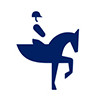 a Summer Games Paralympic Sport
a Summer Games Paralympic SportGoverning Bodies
International Governing Bodies

International Federation for Equestrian Sports
National Governing Bodies
United States

US Equestrian
United States

United States Para-Equestrian Association (USPEA)
Introduction:
Para-equestrian includes two competitive events: One is para-equestrian dressage, which is conducted under the same basic rules as conventional dressage, but with riders divided into different competition grades based on their functional abilities. The other is para-equestrian driving, which operates under the same basic rules as combined driving but places competitors in various grades based on their functional abilities.
History of the Sport:
The first official Paralympic Games was held in Rome in 1960. The Games were initially open only to athletes in wheelchairs; at the 1976 Summer Games, athletes with different disabilities were included for the first time at a Summer Paralympics. Competitors with cerebral palsy classifications were allowed to compete at the Paralympic games for the first time at the 1984 Summer Paralympics. At the 1992 Summer Paralympics, all disability types were eligible to participate, with classification being run through the International Paralympic Committee, with classification being done based on functional disability type.
Para-equestrian dressage was added to the Paralympic Games program at the 1996 Summer Paralympics. The FEI brought para-equestrian sport under its umbrella in 2006. Riders with physical disabilities may compete on the same team as people with vision impairment.
Rules – How to Play the Sport:
Para-dressage
Dressage events include “Walk Only Tests” for Grade 1, with trot work allowed in freestyle, and “Walk and Trot tests” for Grade 2. The dressage events open to Grade 3 classification included “Walk and Trot but Canter allowed in Freestyle”. The dressage events open to Grade 4 classification included “Walk, Trot and Canter and may show lateral work in Freestyle”. In these three grades, participants use a 40 x 20 meter arena. The dressage events open to Grade 5 classification included “Walk, Trot, Canter, Canter Half-Pirouettes, 3 and 4 sequence changes and lateral work.” At Grade 5 participants move up to the 60 x 20 meter arena. All class events are mixed gendered.
Para-driving
The other para-equestrian event is para-driving. It was previously called Carriage Driving. All class events are mixed gendered.
Equipment
The sport is the one with one of the highest rates of injury and illness among all Paralympic sports. For this reason, much of the equipment for the sport is developed with this in mind. Much of the equipment uses Velcro and rubber bands so that things can easily breakaway and protect the rider during a fall. There is also a constant balance in developing equipment for para-equestrian to assure that the rider remains in control, and that they are not dragged along by the horse. One of the adaptions made to saddles for para-equestrian is extra padding. In addition to saddles, para-equestrian riders may use some other form of padding such as a fleece covering for the saddle.
Para-equestrian competitors have both a class and a disability profile number. The profile number impacts which equipment a rider can use, with equipment differences existing in the same class.
Para-equestrian classification
The classification system for para-equestrian sport is a graded system based on the degree of physical or visual disability and handled at the international level by the FEI. The sport has eligible classifications for people with physical and vision disabilities. The sport is open to competitors with impaired muscle power, athetosis, impaired passive range of movement, hypertonia, limb deficiency, ataxia, leg length difference, short stature, and vision impairment. They are grouped into five different classes to allow fair competition. These classes are Grade I, Grade II, Grade III, Grade IV and Grade V. The para-equestrian classification does not consider the gender of the rider, as equestriennes compete in mixed gender competitions. Internationally, classification is handled by FEI.
Para-dressage classification
Para-dressage has five different classes: Grade 1, Grade 2, Grade 3, Grade 4 and Grade 5
The FEI defines this classification as “Grade I. At this level the rider will ride a walk only test. Grade 2, the rider will ride walk with some trot work excluding medium trot.” Federation Equestre International defines Grade 3 as “At this level the rider will ride a novice level test excluding canter.” Federation Equestre International defines Grade 4 as “At this level the rider will ride a novice level test.” The Australian Paralympic Committee defined this classification as: “Grade 4: Athletes with a physical disability or vision impairment. Riders with moderate unilateral impairment, moderate impairment in four limbs or severe arm impairment. In day to day life, riders are usually ambulant but some may use a wheelchair for longer distances or due to lack of stamina. Riders with a vision impairment who compete in this class have total loss of sight in both eyes (B1).” Federation Equestre International defines Grade 5 as “At this level the rider will ride an elementary/medium level test” The Australian Paralympic Committee defined this classification as: “Grade V:, Athletes with a physical disability or vision impairment. Riders have a physical impairment in one or two limbs (for example limb loss or limb deficiency), or some degree of visual impairment (B2).”
Para-driving classification
Para-driving utilizes a different classification system than para-dressage events, and includes only two classes: Grade I and Grade II. Grade 1 is for people who use a wheelchair on a daily basis, and have limited trunk functionality and impairments in their upper limbs. It also includes people who have the ability to walk but have impairments in all of their limbs. The third class of riders it includes is people with severe arm impairments Grade II is for riders who are higher functioning than Grade I riders but who would otherwise be at disadvantage when competing against able-bodied competitors.


